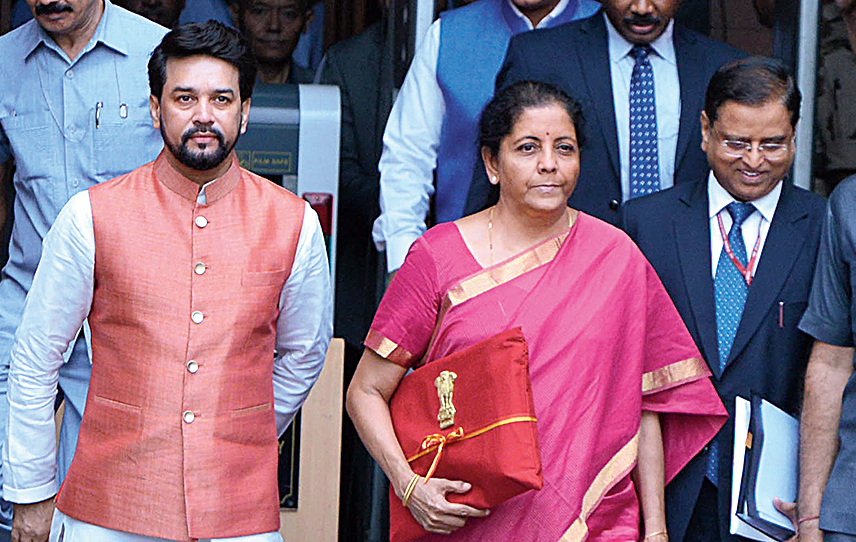The nation had swooned over Narendra Modi’s Mazboot Bharat narrative in April-May, giving the BJP a thumping victory in the Lok Sabha polls. The success of the saffron camp in spinning narratives was in full display on Friday when Nirmala Sitharaman rose to present the Union budget 2019-20 that the ruling dispensation in Delhi termed #BudgetForNewIndia.
The finance minister took 127 minutes — the length of a standard Bollywood flick — to roll out a budget that Modi later described as “citizen-friendly, development-friendly and future-oriented”. In a televised address, the Prime Minister said the budget will “empower the poor and provide better future to the youth”.
After commending the budget, Sitharaman, as an afterthought, addressed the key question of any budget and let the world know that the government would cut its fiscal deficit target to 3.3 per cent of GDP in 2019-20 against 3.4 per cent estimated earlier.
This indeed came as a surprise as analysts were expecting the finance minister to retain the 3.4 per cent fiscal deficit target if not raise it further in view of the slowing down of the economy and poor revenue collection track record.
Fiscal deficit is the difference between the government’s revenue receipts plus non-debt capital receipts and the total expenditure and that’s why is reflective of the total borrowing requirements.
On Friday, Sitharaman’s fiscal deficit feat brought cheers in the bond markets and the impact was immediately felt with a reduction in yield on the 10-year G-Sec by 10 basis points.
However, a closer look at the budget documents brings the claim under stress. Global ratings agency Moody’s Investors Service flagged its concern with the number, but used a politically correct and milder expression. The goal of achieving a lower fiscal deficit, the agency said, looked challenging.
The reasons can be found in the budget document.
First, the fiscal deficit feat can be linked to a higher denominator that Sitharaman used while calculating fiscal deficit, which is expressed as a percentage of GDP.
A note at the bottom of the Budget at a Glance page, which is part of the budget documents, clearly mentions: “GDP for BE 2019-2020 has been projected at Rs 21100607 crore assuming 12 per cent growth over the estimated GDP of Rs 18840731 crore for 2018-2019 (RE).”
Simply put, this means, given the slowdown in growth in recent quarters — India’s economy expanded at 5.8 per cent in the March quarter, its slowest pace in nearly five years — and the underlying trend in inflation, such growth appears a tall task and the high growth figure in the denominator has helped Sitharaman.
Second, a one-line explanation, along with details of the government’s capital expenditure, gives a hint that the finance ministry officials relied on off-budget borrowing to present the fiscal deficit numbers. The explanatory note with IEBR (internal and extra budgetary resources) reads: “For the sake of comparison with BE 2019-20, an amount of Rs 97,000 crore of NSSF loans to FCI should be excluded in RE 2018-19.”
This means, IEBR — which means funds raised by the central public sector units through profits, loans and equity — is a component of government’s capital expenditure. It is, however, not taken into account while calculating fiscal deficit. If taken, the claim of fiscal prudence will go awry.
Third, the fiscal deficit number hinges on the government’s revenue mobilisation abilities, but meeting the targets — like a 23 per cent rise in corporation tax mop up — for this financial year may be easier said than done. Given the track record in GST collection, the target of Rs 6,63,343 crore looks a tall order.
The crux is, there are chances of slippages from the Centre’s fiscal deficit target, as the assumption of revenue buoyancy may not come true.
One doesn’t have to be a fiscal conservative to ask these questions. A democratically elected government has to face these posers if budget pronouncements are accompanied by tall claims that India is on its way to become a $5 trillion economy.
“Today we are nearing a 3-trillion dollar level. So when we aspire to reach a 5-trillion dollar level, many wonder if it is possible. If we can appreciate our citizens’ ‘purusharth’ or their ‘goals of human pursuit’ filled with their inherent desire to progress led by the dedicated leadership present in this House, the target is eminently achievable,” Sitharaman said in her budget speech.
Having set the goal, she passed on the responsibility of reaching it to India Inc before proposing her initiatives to kick-start the virtuous cycle of domestic and foreign investments. That’s the primary job of finance ministers across the globe. But the job also involves recognition of the objective reality.
In her desperation to achieve the fiscal deficit feat, Sitharaman seems to have glossed over the signs of a slowdown. Ten years ago, Pranab Mukherjee — faced with the challenge of slow down caused by both domestic and international factors — was brave enough to press a pause button on fiscal consolidation and tried to give the economy a boost with a stimulus package.
Sitharaman spun a narrative, listed some intent but did little to give the economy a much-needed push.










